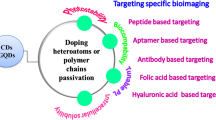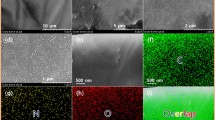Abstract
To solve the problem of high temperature or long reaction time in hydrothermal synthesis of carbon dots (CDs), a novel method based on the promoting carbonization by hydrochloric acid as catalysis was developed in present work. The acid catalyzed carbon dots (ACDs) were prepared facilely from tryptophan and phenylalanine at 200 °C for 2 h. In our findings, the acids could promote significantly the formation of the ACDs’ carbon core, as a result of the accelerating of the carbonization due to the easy deoxidation. The ACDs showed an average size of 4.8 nm, and consisted of high carbon crystalline core and various surface groups. The ACDs exhibited good optical properties and pH-dependent photoluminescence (PL) intensities. Furthermore, the ACDs were safe and biocompatible. The experimental results demonstrated that such new ACDs were connected with DNA-aptamer by EDC/NHS reaction maintaining both the bright fluorescence and recognizing ability on the cancer cells, which so could be served as an effective PL sensing platform. The resultant DNA-aptamer with ACDs (DNA-ACDs) could stick to human breast cancer cells (MCF-7) specifically, and exhibited high sensitivity and selectivity, indicating the potential applications in the cancer cells targeted imaging fields.

Similar content being viewed by others
References
Georgakilas, V.; Perman, J. A.; Tucek, J.; Zboril, R. Broad family of carbon nanoallotropes: Classification, chemistry, and applications of fullerenes, carbon dots, nanotubes, graphene, nanodiamonds, and combined superstructures. Chem. Rev. 2015, 115, 4744–4822.
Jiang, K.; Sun, S.; Zhang, L.; Lu, Y.; Wu, A. G.; Cai, C. Z.; Lin, H. W. Red, green, and blue luminescence by carbon dots: Full-color emission tuning and multicolor cellular imaging. Angew. Chem., Int. Ed. 2015, 54, 5360–5363.
Zhu, A. W.; Qu, Q.; Shao, X. L.; Kong, B.; Tian, Y. Carbondot-based dual-emission nanohybrid produces a ratiometric fluorescent sensor for in vivo imaging of cellular copper ions. Angew. Chem., Int. Ed. 2012, 124, 7297–7301.
Zheng, M.; Liu, S.; Li, J.; Qu, D.; Zhao, H. F.; Guan, X. G.; Hu, X. L.; **e, Z. G.; **g, X. B.; Sun, Z. C. Integrating oxaliplatin with highly luminescent carbon dots: An unprecedented theranostic agent for personalized medicine. Adv. Mater. 2014, 26, 3554–3560.
Ge, J. C.; Jia, Q. Y.; Liu, W. M.; Guo, L.; Liu, Q. Y.; Lan, M. H.; Zhang, H. Y.; Meng, X. M.; Wang, P. F. Redemissive carbon dots for fluorescent, photoacoustic, and thermal theranostics in living mice. Adv. Mater. 2015, 27, 4169–4177.
Huang, S.; Wang, L. M.; Zhu, F. W.; Su, W.; Sheng, J. R.; Huang, C. S.; **ao, Q. A ratiometric nanosensor based on fluorescent carbon dots for label-free and highly selective recognition of DNA. RSC Adv. 2015, 5, 44587–44597.
Liu, C. J.; Zhang, P.; Zhai, X. Y.; Tian, F.; Li, W. C.; Yang, J. H.; Liu, Y.; Wang, H. B.; Wang, W.; Liu, W. G. Nanocarrier for gene delivery and bioimaging based on carbon dots with PEI-passivation enhanced fluorescence. Biomaterials 2012, 33, 3604–3613.
Huang, P.; Lin, J.; Wang, X. S.; Wang, Z.; Zhang, C. L.; He, M.; Wang, K.; Chen, F.; Li, Z. M.; Shen, G. X. et al. Light-triggered theranostics based on photosensitizerconjugated carbon dots for simultaneous enhanced-fluorescence imaging and photodynamic therapy. Adv. Mater. 2012, 24, 5104–5110.
Dong, Y. Q.; Pang, H. C.; Yang, H. B.; Guo, C. X.; Shao, J. W.; Chi, Y. W.; Li, C. M.; Yu, T. Carbon-based dots codoped with nitrogen and sulfur for high quantum yield and excitation-independent emission. Angew. Chem., Int. Ed. 2013, 52, 7800–7804.
Zhu, S. J.; Song, Y. B.; Zhao, X. H.; Shao, J. R.; Zhang, J. H.; Yang, B. The photoluminescence mechanism in carbon dots (graphene quantum dots, carbon nanodots, and polymer dots): Current state and future perspective. Nano Res. 2015, 8, 355–381.
Tao, H. Q.; Yang, K.; Ma, Z.; Wan, J. M.; Zhang, Y. J.; Kang, Z. H.; Liu, Z. In vivo NIR fluorescence imaging, biodistribution, and toxicology of photoluminescent carbon dots produced from carbon nanotubes and graphite. Small 2012, 8, 281–290.
Zhu, S. J.; Meng, Q. N.; Wang, L.; Zhang, J. H.; Song, Y. B.; **, H.; Zhang, K.; Sun, H. C.; Wang, H. Y.; Yang, B. Highly photoluminescent carbon dots for multicolor patterning, sensors, and bioimaging. Angew. Chem., Int. Ed. 2013, 52, 3953–3957.
Algarra, M.; Pérez-Martín, M.; Cifuentes-Rueda, M.; Jiménez-Jiménez, J.; Esteves da Silva, J. C. G.; Bandosz, T. J.; Rodríguez-Castellón, E.; López Navarrete, J. T.; Casado, J. Carbon dots obtained using hydrothermal treatment of formaldehyde. Cell imaging in vitro. Nanoscale 2014, 6, 9071–9077.
Wang, C. X.; Xu, Z. Z.; Cheng, H.; Lin, H. H.; Humphrey, M. G.; Zhang, C. A hydrothermal route to water-stable luminescent carbon dots as nanosensors for pH and temperature. Carbon 2015, 82, 87–95.
Pei, S. P.; Zhang, J.; Gao, M. P.; Wu, D. Q.; Yang, Y. X.; Liu, R. L. A facile hydrothermal approach towards photoluminescent carbon dots from amino acids. J. Colloid Interf. Sci. 2015, 439, 129–133.
Fan, R. J.; Sun, Q.; Zhang, L.; Zhang, Y.; Lu, A. H. Photoluminescent carbon dots directly derived from polyethylene glycol and their application for cellular imaging. Carbon 2014, 71, 87–93.
Yang, S. T.; Wang, X.; Wang, H. F.; Lu, F. S.; Luo, P. G.; Cao, L.; Meziani, M. J.; Liu, J. H.; Liu, Y. F.; Chen, M. et al. Carbon dots as nontoxic and high-performance fluorescence imaging agents. J. Phys. Chem. C 2009, 113, 18110–18114.
Zhao, Q. L.; Zhang, Z. L.; Huang, B. H.; Peng, J.; Zhang, M.; Pang, D. W. Facile preparation of low cytotoxicity fluorescent carbon nanocrystals by electrooxidation of graphite. Chem. Commun. 2008, (41), 5116–5118.
Sun, B. Z.; Duan, L.; Peng, G. G.; Li, X. X.; Xu, A. H. Efficient production of glucose by microwave-assisted acid hydrolysis of cellulose hydrogel. Bioresource Technol. 2015, 192, 253–256.
Wang, X. H.; Qu, K. G.; Xu, B. L.; Ren, J. S.; Qu, X. G. Microwave assisted one-step green synthesis of cell-permeable multicolor photoluminescent carbon dots without surface passivation reagents. J. Mater. Chem. 2011, 21, 2445–2450.
Mazzier, D.; Favaro, M.; Agnoli, S.; Silvestrini, S.; Granozzi, G.; Maggini, M.; Moretto, A. Synthesis of luminescent 3D microstructures formed by carbon quantum dots and their self-assembly properties. Chem. Commun. 2014, 50, 6592–6595.
Liu, B.; Yang, F. K.; Liu, G. Y.; Yang, X. L. Synthesis of CdS/SiO2/polymer tri-layer fluorescent nanospheres with functional polymer shells. Chin. J. Polym. Sci. 2012, 30, 359–369.
Ding, H.; Du, F. Y.; Liu, P. C.; Chen, Z. J.; Shen, J. C. DNA–carbon dots function as fluorescent vehicles for drug delivery. ACS Appl. Mater. Inter. 2015, 7, 6889–6897.
Cao, H. M.; Ye, D. X.; Zhao, Q. Q.; Luo, J.; Zhang, S.; Kong, J. L. A novel aptasensor based on MUC-1 conjugated CNSs for ultrasensitive detection of tumor cells. Analyst 2014, 139, 4917–4923.
Wang, X.; Cao, L.; Yang, S. T.; Lu, F. S.; Meziani, M. J.; Tian, L. L.; Sun, K. W.; Bloodgood, M. A.; Sun, Y. P. Bandgap-like strong fluorescence in functionalized carbon nanoparticles. Angew. Chem., Int. Ed. 2010, 49, 5310–5314.
Jiang, J.; He, Y.; Li, S. Y.; Cui, H. Amino acids as the source for producing carbon nanodots: Microwave assisted one-step synthesis, intrinsic photoluminescence property and intense chemiluminescence enhancement. Chem. Commun. 2012, 48, 9634–9636.
Sun, D.; Ban, R.; Zhang, P. H.; Wu, G. H.; Zhang, J. R.; Zhu, J. J. Hair fiber as a precursor for synthesizing of sulfur- and nitrogen-co-doped carbon dots with tunable luminescence properties. Carbon 2013, 64, 424–434.
Qin, X. Y.; Lu, W. B.; Asiri, A. M.; Al-Youbi, A. O.; Sun, X. P. Green, low-cost synthesis of photoluminescent carbon dots by hydrothermal treatment of willow bark and their application as an effective photocatalyst for fabricating Au nanoparticles-reduced graphene oxide nanocomposites for glucose detection. Catal. Sci. Technol. 2013, 3, 1027–1035.
Liu, S.; Tian, J. Q.; Wang, L.; Zhang, Y. W.; Qin, X. Y.; Luo, Y. L.; Asiri, A. M.; Al-Youbi, A. O.; Sun, X. P. Hydrothermal treatment of grass: A low-cost, green route to nitrogen-doped, carbon-rich, photoluminescent polymer nanodots as an effective fluorescent sensing platform for label-free detection of Cu(II) ions. Adv. Mater. 2012, 24, 2037–2041.
Lim, S. Y.; Shen, W.; Gao, Z. Q. Carbon quantum dots and their applications. Chem. Soc. Rev. 2015, 44, 362–381.
Li, X. M.; Zhang, S. L.; Kulinich, S. A.; Liu, Y. L.; Zeng, H. B. Engineering surface states of carbon dots to achieve controllable luminescence for solid-luminescent composites and sensitive Be2+ detection. Sci. Rep. 2014, 4, 4976.
Cao, L.; Wang, X.; Meziani, M. J.; Lu, F. S.; Wang, H. F.; Luo, P. G.; Lin, Y.; Harruff, B. A.; Veca, L. M.; Murray, D. et al. Carbon dots for multiphoton bioimaging. J. Am. Chem. Soc. 2007, 129, 11318–11319.
Ferreira, C. S. M.; Matthews, C. S.; Missailidis, S. DNA aptamers that bind to MUC1 tumour marker: Design and characterization of MUC1-binding single-stranded DNA aptamers. Tumor Biol. 2006, 27, 289–301.
Author information
Authors and Affiliations
Corresponding authors
Additional information
These authors contributed equally to this work.
Electronic supplementary material
Rights and permissions
About this article
Cite this article
Wang, Z., Fu, B., Zou, S. et al. Facile construction of carbon dots via acid catalytic hydrothermal method and their application for target imaging of cancer cells. Nano Res. 9, 214–223 (2016). https://doi.org/10.1007/s12274-016-0992-2
Received:
Revised:
Accepted:
Published:
Issue Date:
DOI: https://doi.org/10.1007/s12274-016-0992-2




